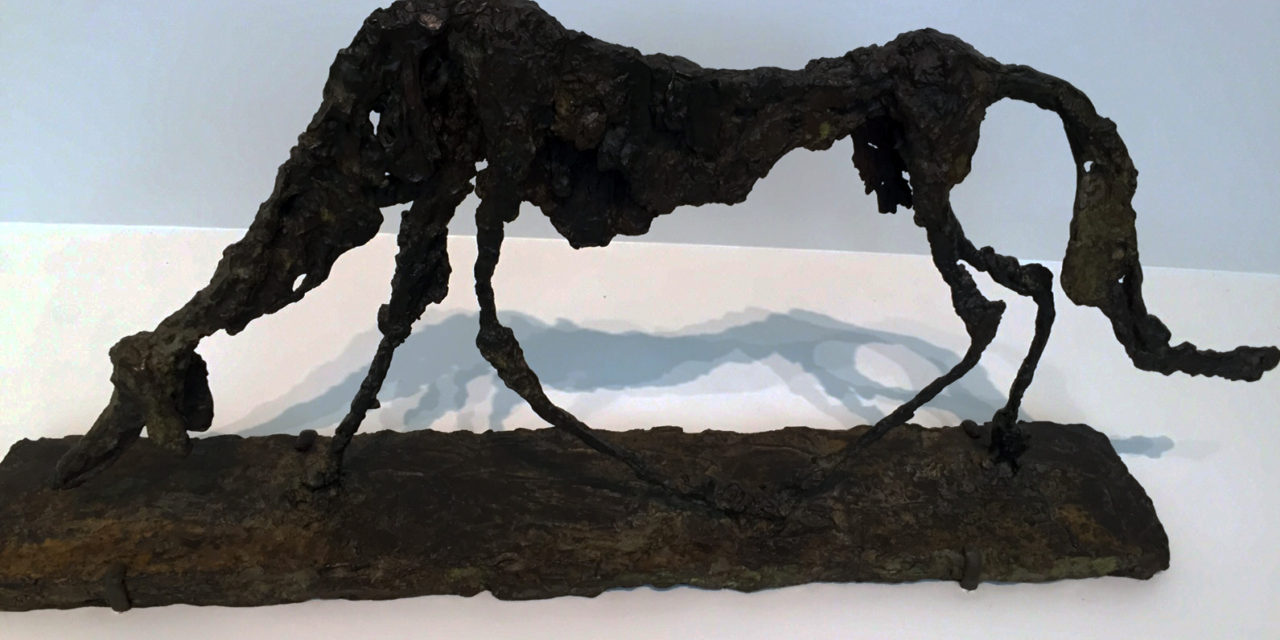Thursday is the Guggenheim’s day off. I can’t tell you how many tourists brayed at the announcement. I was watching them from the shade of the main entrance, waiting for my girlfriend to join me for a private showing of the new Giacometti exhibit at 3:00. Don’t get me wrong, I’m a tourist, too. I’ve been here ten years, and I still can’t measure the immensity of the place.
Now the guy who arranged this private showing lives in my building along with other museum curators and more bizarre individuals, opera singers and the like. He builds things, always has, and he comes from a Protestant background so deep that making cabinets and saving souls are not similar activities, they’re the same thing.
This was the second time I’ve had a private, silent showing of an exhibition he built from the blueprints the curator posited. He’s that generous. We got into the museum by way of the staff entrance, around the corner on 89th.
We took the elevator to the top floor, so we walked down, from most recent to most ancient artifacts. “Verticality,” my girlfriend, once a video artist, said, “Wow.” True enough, everything was up and down, as in death-defying sculptural acrobatics. Tall ragged legs, often topped by faces, all of them imitations of what you see every day, on the street, each of them a specimen of dessication, more muscle and bone, more decay and decimation than growth.
The first object off the elevator was a dog sculpture, head down, shriveled up, limping along. Giacometti wrote to his friend Jean Genet, “One day I saw myself in the street like that. I was that dog.” Me, too. I have a whole chapter of the memoir called “My Life as a Dog,” in which I explain in words rather than wrought iron what this condition means. It’s not unusual, and it’s not altogether unpleasant, mind you, being a dog. My life as one was quite enjoyable until I decided I’d prefer to be a human being.
I couldn’t help but think that Frank Lloyd Wright wanted us to see the old or new layer of art, the next or the last moment of our beholding, as we walked down, imperceptibly, and sometimes stood before the museum’s artificial present. At any rate I kept looking over those rounded shoulders, the rims of the walkway, and wondering how these artifacts–which would appear only in the peripheral vision Wright imposed with his spiral–could go together. Or whether they could.
Giacometti went through several “phases,” including a cubist and a surrealist and an existential stage. But the movement I witnessed in the drawings and the sculptures, as we descended, was the arc of a death wish. I don’t mean he was suicidal—-there’s too much of everyday life in these artifacts. No, I mean that he let death inform every moment of his life as an artist. The immediacy of these things springs from this attitude, knowing that death is your lover, your loyalty, your constant companion, the only one who will never leave you because he can’t.
Here’s another way to describe the movement or the rhythm of the work, early to late–if, that is, one needs to periodize an artist’s evolution. The early sculptures are abstract, heavy and weighty and smooth as in the gigantic monoliths or monuments of antiquity. There’s nothing abstract about the late three-dimensional pieces–they’re close and gnarly, full of painful, decaying musculature, as if Giacometti’s purpose late in life was to peel away everything–including abstraction, whether visual or verbal–that could get in the way of seeing our souls. Not that these are “realistic” renditions of anything you’d encounter outside his studio or the museum (what’s so realistic about your soul, anyway?). No, I’m trying to say that this artist wanted to strip things down, get to the bare bones of his existence and ours. Why? No idea. I’m not even sure that I approve of the procedure–without metaphor, abstraction, or some kind of distance from the objects of our scrutiny, us human beings tend to get ugly, angry, and violent about them. We become animals. “I was that dog.”

